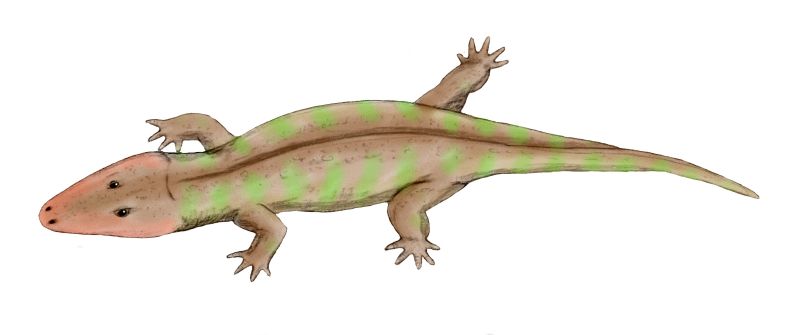Rhinesuchus on:
[Wikipedia]
[Google]
[Amazon]

 ''Rhinesuchus'' (meaning "rasp crocodile" for the ridged surface texture on its skull bones) is a large
''Rhinesuchus'' (meaning "rasp crocodile" for the ridged surface texture on its skull bones) is a large

 ''Rhinesuchus'' (meaning "rasp crocodile" for the ridged surface texture on its skull bones) is a large
''Rhinesuchus'' (meaning "rasp crocodile" for the ridged surface texture on its skull bones) is a large temnospondyl
Temnospondyli (from Greek τέμνειν, ''temnein'' 'to cut' and σπόνδυλος, ''spondylos'' 'vertebra') is a diverse order of small to giant tetrapods—often considered primitive amphibians—that flourished worldwide during the Carb ...
amphibian
Amphibians are four-limbed and ectothermic vertebrates of the class Amphibia. All living amphibians belong to the group Lissamphibia. They inhabit a wide variety of habitats, with most species living within terrestrial, fossorial, arbo ...
. Remains of the genus are known from the Permian
The Permian ( ) is a geologic period and stratigraphic system which spans 47 million years from the end of the Carboniferous Period million years ago (Mya), to the beginning of the Triassic Period 251.9 Mya. It is the last period of the Paleo ...
of the South Africa
South Africa, officially the Republic of South Africa (RSA), is the southernmost country in Africa. It is bounded to the south by of coastline that stretch along the South Atlantic and Indian Oceans; to the north by the neighbouring coun ...
n Karoo
The Karoo ( ; from the Afrikaans borrowing of the South Khoekhoe !Orakobab or Khoemana word ''ǃ’Aukarob'' "Hardveld") is a semi-desert natural region of South Africa. No exact definition of what constitutes the Karoo is available, so its ex ...
Basin's ''Tapinocephalus'' and ''Cistecephalus'' assemblage zones, both belonging to the Beaufort Group
The Beaufort Group is the third of the main subdivisions of the Karoo Supergroup in South Africa. It is composed of a lower Adelaide Subgroup and an upper Tarkastad Subgroup. It follows conformably after the Ecca Group and unconformably underli ...
. The skull of ''Rhinesuchus'' had a flat triangular shape with blunt snout similar to some of the other large amphibians, and had a palate
The palate () is the roof of the mouth in humans and other mammals. It separates the oral cavity from the nasal cavity.
A similar structure is found in crocodilians, but in most other tetrapods, the oral and nasal cavities are not truly separ ...
filled with small sharp teeth, suggesting that it hunted fish. Also, the small eyes were on top of the head suggesting that it approached its prey from below.
The name ''Rhinesuchus'' comes from Greek ρίνη (''rhine'') "file, rasp" plus σούχος (''soukhos'') "crocodile" for the skull surface texture: "The upper cranial bones are ornamented by a rather fine reticulation of sharp ridges". (The name does not mean "nose crocodile" (as if from Greek ''rhis, rhinos'' "nose") or refer to the Rhine River in Germany.)
The type species is ''Rhinesuchus whaitsi''. Two more species, ''R. africanus'' and ''R. wadiai'', are considered to be ''nomen dubium
In binomial nomenclature, a ''nomen dubium'' (Latin for "doubtful name", plural ''nomina dubia'') is a scientific name that is of unknown or doubtful application.
Zoology
In case of a ''nomen dubium'' it may be impossible to determine whether a s ...
''. ''R. broomianus'' and ''R. beaufortensis'' have been synonymized with ''R. whaitsi'', while ''R. capensis'' has been moved out of the genus into ''Rhinesuchoides
''Rhinesuchoides'' is an extinct genus of prehistoric temnospondyl in the family Rhinesuchidae. It contains two species, ''R. tenuiceps'' and ''R. capensis'', both from the Karoo Supergroup of South Africa. The latter was formerly a species of ...
''. ''Muchocephalus'' has also been synonymized with ''R. whaitsi''. The first rhinesuchid from outside southern Africa was described as ''Rhinesuchus wolgodvinensis'' (Yacovlev, 1916). The specimen, collected from Early Triassic beds from Russia, was considered the first ''Rhinesuchus'' from the Triassic, although currently it is considered, instead, a wetlugasaurid.
Counts of lines of arrested growth (LAG) indicate that like many amphibians, ''Rhinesuchus'' grew seasonally and was able to live more than 30 years. They also indicate that ''Rhinesuchus'' was able to sustain prolonged periods of stress, either climatic or nutritional, and that portions of its skeleton may have experienced more sustained growth.
References
*S. H. Haughton. 1925. Investigations in South African fossil reptiles and amphibians (Part 13). Annals of the South African Museum 22:227-261 *R. Schoch and A. R. Milner. 2000. Stereospondyli. Handbuch der Paläoherpetologie - Encyclopedia of Paleoherpetology 3B:1-203 *R. J. Damiani and B. S. Rubidge. 2003. A review of the South African temnospondyl amphibian record. Palaeontologia africana 39:21-36 Permian amphibians of Africa {{Permian-animal-stub